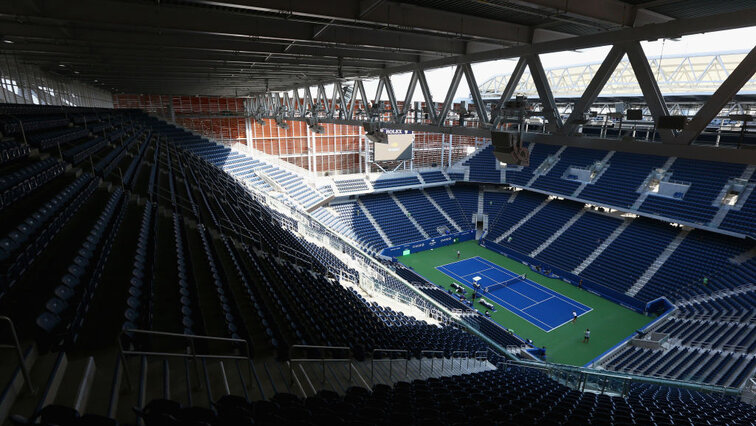US Open: The price of beautification - Debt drives restart
Professional tennis has been back in Palermo for a few days. The really big test will not wait until the end of August in New York City, where it will be served for three weeks under exceptional conditions.
by Jörg Allmeroth
last edit:
Aug 07, 2020, 09:24 am

It was in the 1990s that Boris Becker once said the following about the US Open: "There are a hundred tennis tournaments on this planet," said Becker. "And then there's the US Open." Becker didn't mean that charming, but he was just one of the many stars from the traveling circus who made the Grand Slam spectacle outside New York City for organizational mishaps, confused fixtures, the overwhelming dictates of the US television stations and the ailing infrastructure were scourged. He would love to drop an “atomic bomb” on Flushing Meadow, the Croatian “master of the aces”, Goran Ivanisevic, grumbled about the major competition: “It's a mystery to me,” the service gunner said on record. "How the Americans managed to send people to the moon."
For many years, the last Grand Slam was considered a “scary slam” in the annual calendar, but in the meantime the event in the Big Apple was even on the brink. But the times of chaos are over, the Americans have caught up again in the beauty contest of the four Grand Slam tournaments and can compete with Wimbledon or the Australian Open. Since 2018, the US Open bosses even have three top arenas, as well as the Ashe Stadium, the largest tennis stage in the world, the renewed Grandstand and the upgraded Louis Armstrong Court.
The facelift had its price
But the facelift had its price, and the 600 million dollars that the US association USTA invested in the construction projects and, among other things, the roof over the Center Court, are now the main reason why the tournament organizers in the corona pandemic at almost any price want to host the Grand Slam cup fights from the end of August. The US Open traditionally earns more than any other majors in admission fees and the sale of fan merchandise and souvenirs, but of the $ 350 million in sales in 2018 alone, 120 million flowed from TV partners from around the world. "This is the sum that the USTA intends to collect in 2020 - at least," says a top ITF official. "She also needs the money urgently."
It looks little different at the French Open, which the French federation had arbitrarily and arrogantly relocated in autumn - after a start in the traditional spring time had become impossible. After years of quarrels about relocation plans and, similar to New York, worries about losing Grand Slam status, the Paris organizers wanted to proudly inaugurate their new Center Court roof in 2020. But now at the end of September and beginning of October it's all about somehow getting the two major weeks over the stage with the greatest possible corona discipline and without faux pas. The FFT (Federation Francaise de Tennis) is also under pressure from the debts caused by the ambitious revamping initiative of recent years. The total costs amounted to at least 400 million euros, some scene insiders even speak of half a billion euros. A complete failure of the tournament must "absolutely" be avoided, says the controversial FFT chief Bernard Giudicelli. Unlike Wimbledon, neither the French Open nor the US Open have taken out insurance against a pandemic.
Djokovic, Zverev and Co. have not covered themselves with fame
Beyond the tightly organized show events in Germany and, for example, in neighboring Austria, the tennis hikers have not so far covered themselves with fame during the great health crisis - to put it mildly. Even after the unsuccessful invitation events by Novak Djokovic or a quarantine violation by Alexander Zverev , the headlines are not getting any better - despite the long organizational lead-up, the organizers of the WTA tournament in Palermo this week astonished with the fact that players and tourists in the official hotel feel like they are in carefree times could meet: Because of tennis bubble. France's star player Richard Gasquet called the events a “scandal”: “Something like this should never have happened.” No wonder that the American ex-professional James Blake, recently tournament director of the Miami Open, expressed his concerns about how to win a Grand Slam Event with several hundred participants "without errors" can bring about the stage: "It will be incredibly difficult to maintain this sphere of protection."
Many in the tennis world had long been worried about America, the US Open and the other tournaments there. Many also drew their conclusions early on and announced their withdrawal from the New York spectacle, and Rafael Nadal and Julia Görges have only just been added to this list. More rejections will certainly follow. But in Europe and for the rest of the season, too, things don't look promising. The Masters in Madrid was canceled, the plans of the French Open officials to allow up to 20,000 spectators to visit the by no means generously dimensioned facility met with skepticism and rejection. Most of the traditional Asian tour in autumn has already been shelved, all China tournaments have been canceled by state decree, and there are no competitions in Tokyo either. "Regional, local tournaments are definitely the most reliable at the moment," says DTB Vice Dirk Hordoff. Whereby “at the moment” could still apply for many more months.
